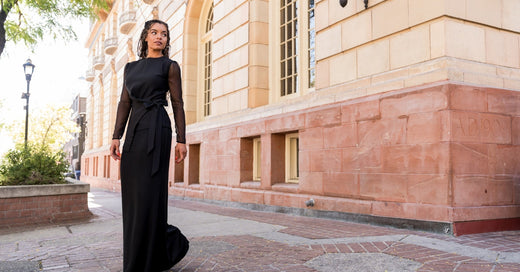
A Step-by-Step Guide to Choosing the Perfect Concert Black Attire
The spotlight awaits, and while your music may speak volumes, your concert attire can make or break your performance. For performing classical musicians, selecting the right black concert attire is about more than just fashion; it's a fusion of comfort, functionality, and style.
Whether you’re looking for professional concert attire or you're a student stepping onto the stage, deciding what to wear can often be as daunting as the performance itself. Choosing the right all-black outfit is crucial for comfort and peak performance. In this guide, we’ll walk you through the steps to help you look, feel, and perform your best.

Finding the perfect concert outfit that balances style and comfort can elevate your confidence and help your achieve peak performance. Now, let’s create an ensemble that truly shines! Follow these steps for a stylish and harmonious look:
Step 1: Follow the Dress Code
Dress codes, particularly for professional orchestras, carry significant weight. Adhering to the rules is crucial, yet one shouldn't feel stifled. Men usually navigate the dress code with ease as white tie and tails, a tuxedo, or a black suit are generally standard. However, women face a more intricate challenge in maintaining formality akin to men while prioritizing comfort.
The majority of women's formal black attire simply doesn't meet the dress code. Alterations and additions are something to consider, such as having a leg slit sewn together, wearing a cami under low-cut necklines, or adding a jacket or shrug over a sleeveless gown. Traditional evening gowns with boning and corsets pose impracticalities for many musicians and many stylish options often don't provide enough coverage to meet the dress code.
Garments that DO meet the dress code are often uncomfortable and matronly, but options are out there if you know where to look. For most ensembles, the dress code is in place to make sure no one is sticking out, so there are a few things you may want to avoid such as cutouts, stripes, sequins and the like.
Step 2: Formal Fabrics
Defining formal and informal fabrics can be tricky, but some choices are clear. Fabrics like satin charmeuse, and peau de soie are popular for formal wear due to their sheen. Lace, chiffon, and velvet are also elegant options, especially on stage. When it comes to formal wear, suiting fabrics with a subtle shine such as wool, rayon, and polyester are also commonly chosen. Although some polyester is designed to mimic the breathability of natural fabrics, many polyester fabrics will trap moisture against your skin, something to beware of if you are performing in a venue know to be warm.
On the flip side, determining informal fabrics is less straightforward. Fabrics like jersey t-shirt material, yoga wear, denim, or leather are where problems often arise. Faded black fabrics generally looks less formal and less professional than fabrics that can maintain a deeply pigmented dark black, so a key consideration is the depth of black color, with fading cotton a common culprit of a washed-out look.
Step 3: Comfort and Ease of Playing
Traditional dress codes typically call for black, formal attire, but comfort doesn't have to be compromised. Whenever possible, choose breathable fabrics such as cotton, silk, or performance materials like lyocell. These fabrics can assist in regulating temperature and wicking away moisture, ensuring you stay cool whether in the spotlight or under the sun as even indoor venues vary in temperature. Having performed many long symphonies in a concert hall that sometimes exceeds 80 degrees, I stress the importance of lightweight, breathable fabrics!
If you're looking to stay cool under hot stage lights, look for garments made with breathable fabric that allow ample airflow around the neck and shoulders such as tops with scoop-backs, v-backs, or boat-necks. Along with 3/4 sleeves, these styles promote airflow effectively for a cool and comfortable stage presence.
Another consideration is how much ease does the garment have. Ease is the amount of space between the garment and a person's body measurements. Some garments are fitted with very little ease while others are designed to be oversized and hang more loosely on the body. A garment's fabric can also give ease if it contains elastane or lycra which can help enable the full range of motion required by performing musicians.
Step 4: Practice
Yes! Practice at least once in any new concert attire at home, especially if experimenting with something new. Something that looked great in a dressing room may feel very different with an instrument in hand. Wind players who often place instruments in their laps need to be extra cautious of sequins, fringe, or ties that could catch on their instruments. Some clothing may feel tighter or more restrictive when sitting rather than standing. Singers and wind players considering shapewear should practice in it to ensure it still allows for comfortable breathing. The same applies to shoes, especially for those who stand while performing.
Conclusion
The right concert attire should make you feel confident and comfortable enough to take on the world. Keep in mind that the ultimate goal is to perform at your best, so don't let your outfit distract from that. With these steps in mind, you'll be well on your way to choosing the perfect concert attire for your next performance. Remember, fashion and functionality.
Parting Thoughts
Remember, the perfect concert outfit is one that reflects your personal style while adhering to the norms of your performance environment. It should empower your performance, not hinder it. Through my own experiences on stage—sweaty palms and all—I’ve learned that when you look good, you feel good, and when you feel good, you play your best.
Share Your Style
Once you’ve settled on your concert attire, why not share your look with fellow musicians? Tag us @BlackstradConcertAttire for a chance to be featured and inspire others. Break a leg!



